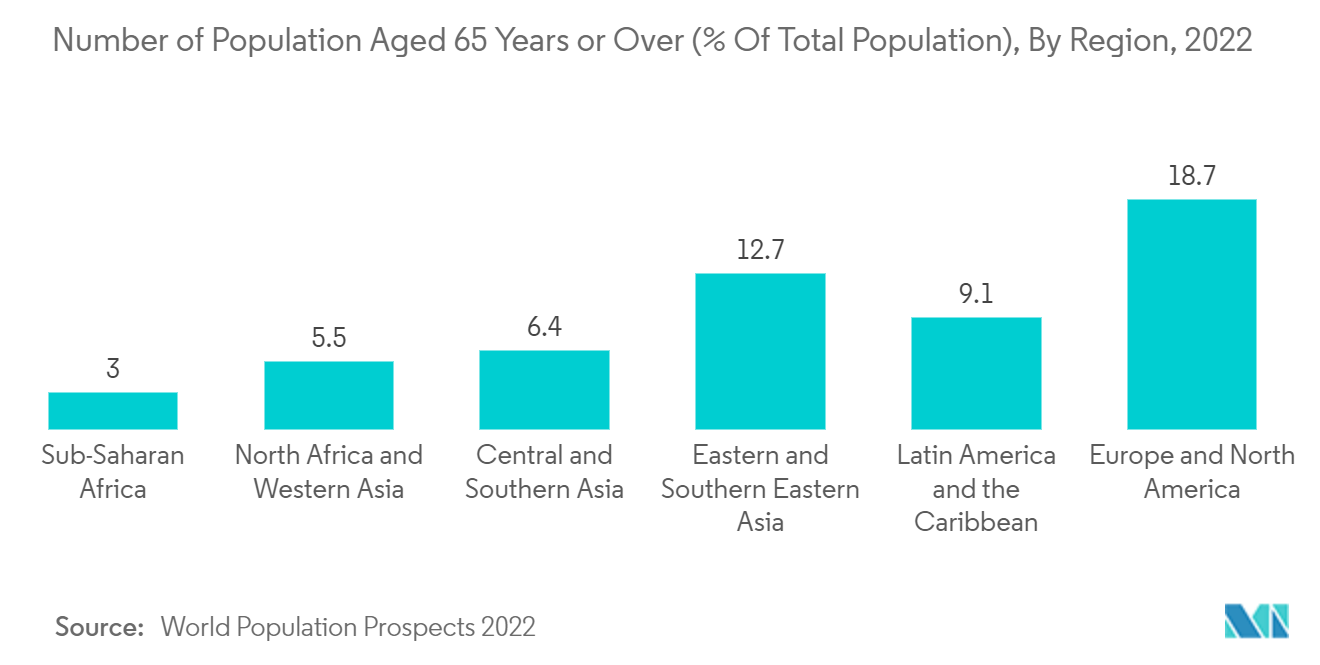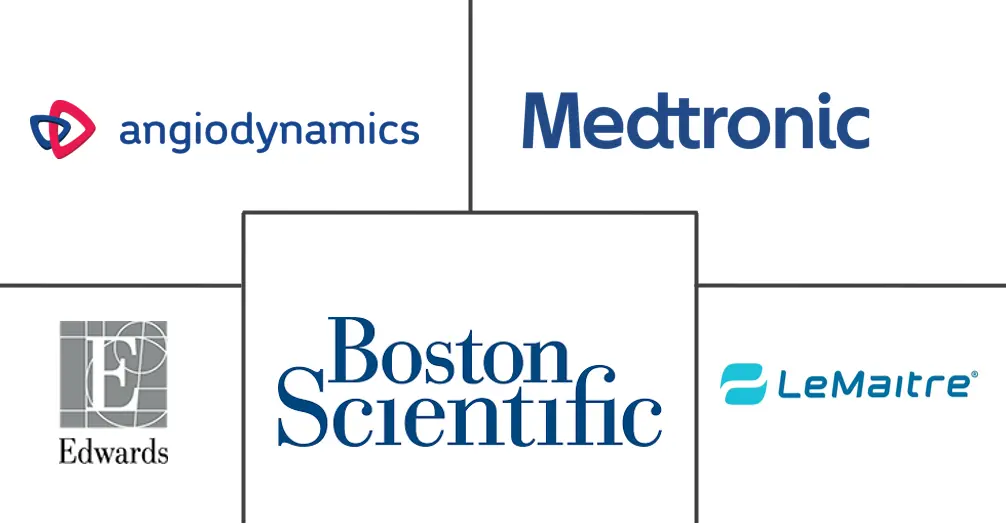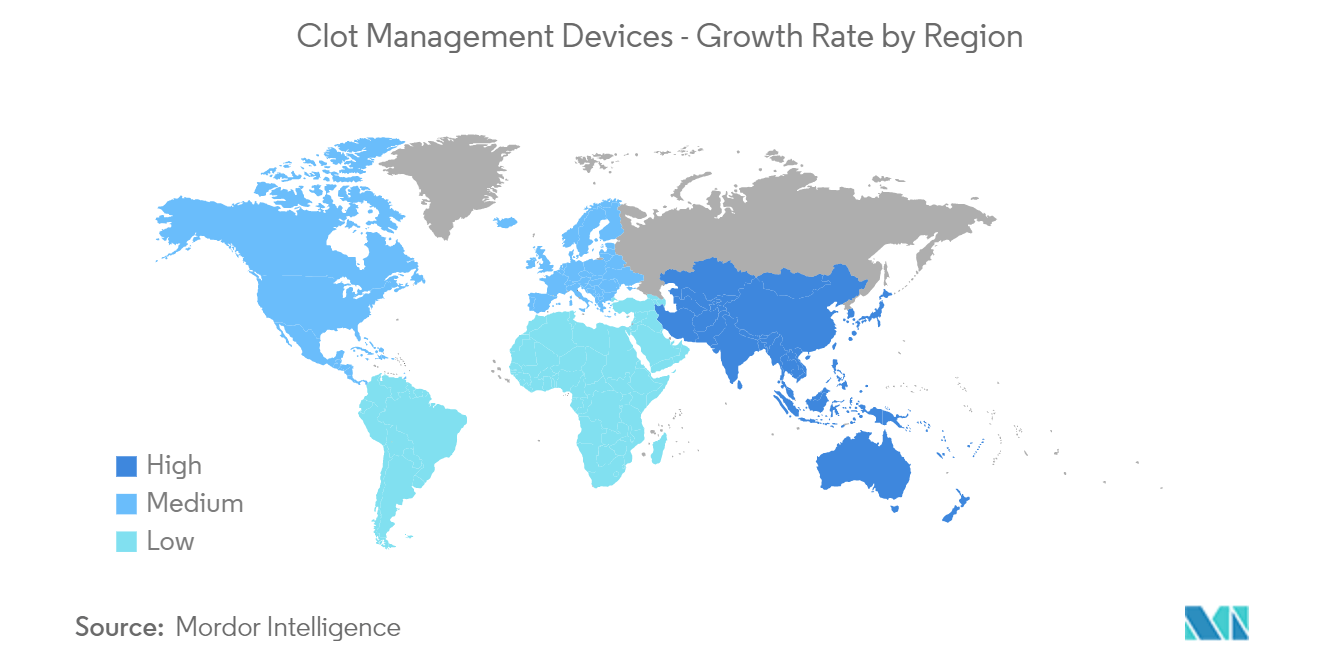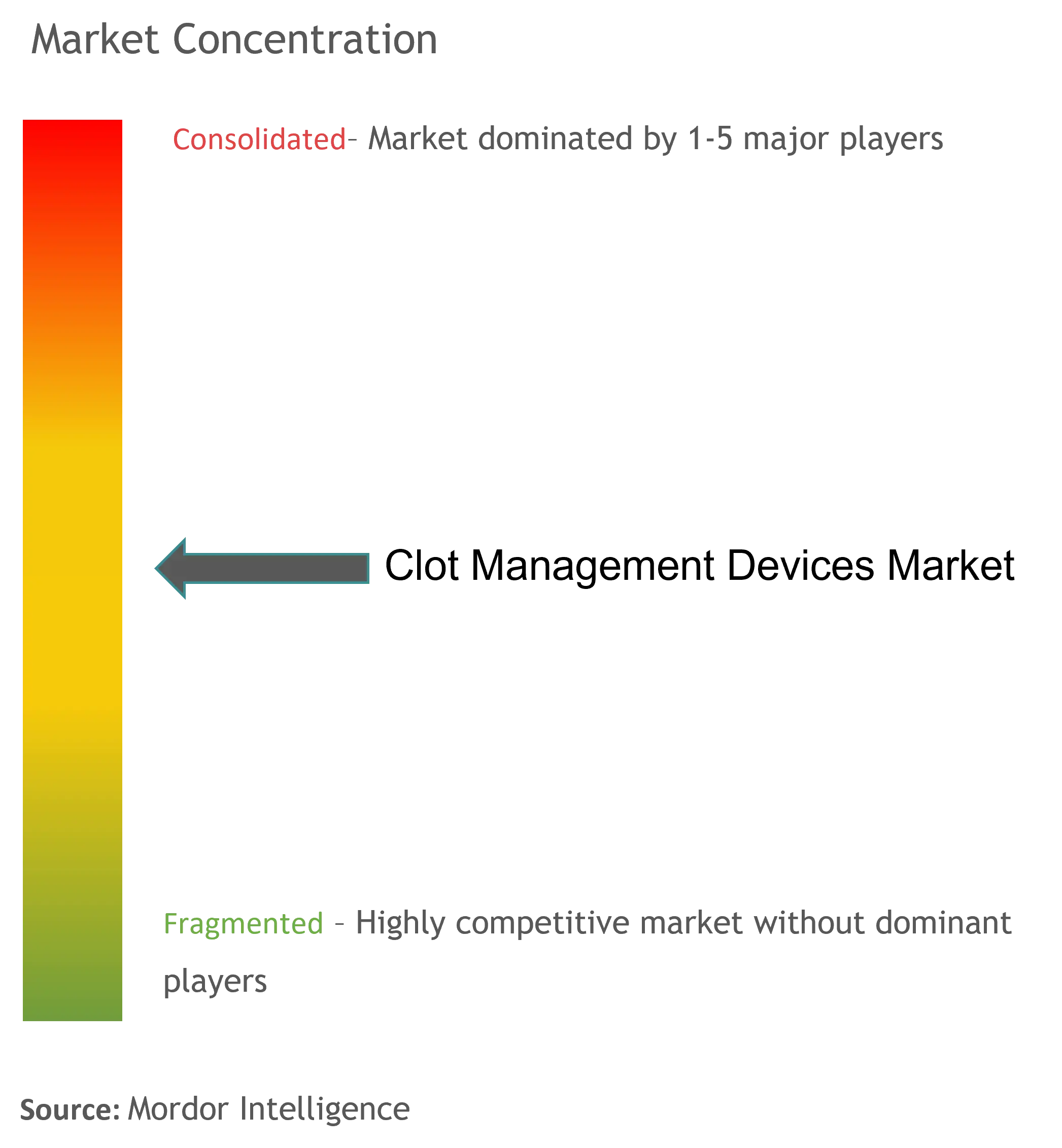
Clot Management Devices Market Analysis
The Clot Management Devices Market size is estimated at USD 1.96 billion in 2025, and is expected to reach USD 2.63 billion by 2030, at a CAGR of 6.04% during the forecast period (2025-2030).
The COVID-19 pandemic had a significant impact on the market studied. The risk of cardiovascular diseases increased during the pandemic and increased the risk of thrombosis (blood clotting) among the target patients. This increased the demand for the devices used for thrombosis management. According to the article "Cardiovascular Disease Management in COVID 19" published in April 2022, blood coagulation (clot) issues have been linked to COVID-19 infection globally.
In addition, another article, "Risks of Deep Vein Thrombosis, Pulmonary Embolism, and Bleeding After COVID-19: Nationwide Self-Controlled Cases Series and Matched Cohort Study," published in April 2022, stated that deep vein thrombosis increased during the pandemic, and it was higher during the initial phase of the pandemic in Sweden. Thus, for the management of thrombosis, the demand for clot management devices increased. This fuelled the studied market growth.
Factors such as the rise in cardiovascular diseases coupled with the increasing geriatric population, growing demand for minimally invasive surgeries, and technological advancements contribute to market growth. The rising geriatric population across the world is creating various disease burdens. This leads to increasing surgeries and blood clots among the target population.
The World Health Organization (WHO) estimates that by 2050, there will be 2.1 billion people worldwide who are 60 years of age or older, up from 1 billion in 2020. In addition, several sources and research show that the population aged 60 years or more is the foremost independent risk factor for deep vein thrombosis (when blood clot forms in one or more of the deep veins in the body). Thus, the increasing geriatric population coupled with the burden of thrombosis among them is expected to create demand for clot management devices, thereby driving the market growth over the analysis period.
Additionally, the global market for clot management devices has increased in recent years in product innovation, approval, and launches. For instance, in November 2021, Precision Medical Products (PMP) released the newest iteration of its Circul8 Pro device, a powerful and portable take-home deep vein thrombosis (DVT) prevention product. With 20-plus-hour battery life, the Circul8 Pro is one of the market's longest-lasting portables, battery-operated compression devices. Thus, such advances in the market are predicted to drive the studied market growth globally. Thus, the studied market is expanding with innovation and launches.
However, the stringent regulatory process and availability of alternative treatments are expected to restrain the market's growth.
Clot Management Devices Market Trends
Embolectomy Balloon Catheter Segment is Expected to Register Significant Growth
- During a surgical thrombectomy, a surgeon makes an incision into a blood vessel to remove the clot and repair the blood vessel to restore blood flow. Sometimes, a balloon or other device may be put in the blood vessel to help keep it open. A balloon embolectomy catheter is then used to retrieve any proximal or distal thrombus (blood clot). Thus, with the increasing number of coronary artery diseases and other cardiovascular diseases (CVDs), the demand for such devices is increasing. This is expected to fuel the segment's growth over the forecast period.
- Several embolectomy balloon catheters are available commercially, which help in removing fresh, soft emboli and thrombi from vessels in the arteries of the non-central circulatory system. For instance, the Fogarty arterial embolectomy catheter available on the market is hand-tied using a recessed winding technique to secure the balloon to the catheter. The balloon exhibits a symmetry that exerts uniform contact with vessel walls for even pressure and precise traction. It has a rounded tip that promotes easy insertion for reduced trauma. Thus, such availability of products and innovation of products by the major players is anticipated to fuel the segment's growth.
- Furthermore, various product launches are fuelling the segment's growth. For instance, in February 2022, Vena Medical received the first Health Canada medical device license for its new product, the Vena balloon distal access catheter. It combines the balloon guide catheters and distal access catheters currently used in thrombectomy to remove clots from the brains of stroke patients. Such developments are expected to fuel segment growth.
- Therefore, owing to the factors mentioned above, the embolectomy balloon catheter segment is poised to witness growth over the forecast period.

North America is Expected to have Significant Market Share
- North America is anticipated to witness growth over the forecast period and dominate the market. Among other countries in the region, the United States is leading the market due to increased healthcare expenditure, product innovation, and a rising prevalence of cardiovascular diseases. Additionally, the increasing geriatric population across the United States is the primary driver for the US clot management devices market.
- Several research papers and sources mentioned that people who have coronary artery disease (CAD) are predisposed to blood clots that can result in a heart attack or stroke. This is because some plaques (fatty deposits), in addition to reducing blood flow through the arteries, can rupture. Thus, the management of blood clots in CAD patients is necessary. Hence, the burden of CAD in the United States is anticipated to drive demand for blot clot management devices, thereby driving market growth in the region.
- Furthermore, blood clots are generally seen in patients 65 years old or older. As people age, mobility decreases, and the chances of surgery and hospice care increase. This is because blood clots can form in the legs due to immobility and older people are more prone to getting blood clots in the legs. The data updated in February 2022 by the United States Department of Health and Human Services (USHHS) shows that the population in the United States is aging unprecedently, and the population aged 65 or older is projected to reach 23.5% (98 million) by 2060 in the country. Hence, the prevalence of blood clots in the country is increasing and is predicted to continue due to the increasing geriatric population. Thus, it is predicted to create demand for blood clot management devices. Hence, the studied market is anticipated to grow over the forecast period in the United States.
- Moreover, the increasing product launches and approvals for innovations in countries across North America are fuelling the studied market growth during the forecast period. For instance, in February 2022, Imperative Care, Inc. launched its Zoom POD Aspiration Tubing, the company's latest innovation in stroke treatment and the first and only filter to capture clots in the sterile field. The Zoom POD is the newest addition to Imperative Care's Zoom Stroke Solution, the company's ischemic stroke product portfolio that includes the Zoom 88 Large Distal Platform for neurovascular access, four Zoom Aspiration Catheters in various sizes, and the Zoom Pump with accessories. Such developments are fuelling the overall market growth in the region.
- Therefore, owing to the factors mentioned above, North America is predicted to witness growth over the forecast period.
Clot Management Devices Industry Overview
The clot management devices market is moderately competitive and consists of a few market players globally and regionally. Market players focus on product innovations, new product launches, and regional expansions to increase their market share. The key market players operating in the clot management devices market include Medtronic Plc, Boston Scientific Corporation, Edward Lifesciences, AngioDynamics, Inc., and LeMaitre Vascular, Inc., among others.
Clot Management Devices Market Leaders
-
Medtronic Plc
-
Boston Scientific Corporation
-
Edward Lifesciences
-
AngioDynamics, Inc.
-
LeMaitre Vascular, Inc.
- *Disclaimer: Major Players sorted in no particular order
Clot Management Devices Market News
- April 2022: Penumbra, Inc., a global healthcare company focused on innovative therapies, announced that its Indigo Aspiration System with Lightning 7 and Lightning 12, designed for a single session blood clot removal in peripheral arterial and venous systems, including the treatment of pulmonary embolisms. The product secured the CE Mark and is now commercially available in Europe.
- April 2022: Medtronic launched a registry for collecting real-world data associated with revascularisation devices in acute ischemic stroke (AIS) patients. The Prospective Registry for Assessment of Acute Ischemic Stroke Patients Treated with Neuro thrombectomy Devices in India (PRAAN) is an industry-first endeavor to create a post-market registry to assess clinical outcomes associated with the use of Medtronic market-released revascularisation devices in patients experiencing acute ischemic stroke. The duration of the registry will be approximately 28 months, and up to 200 subjects will be enrolled in it.
Clot Management Devices Industry Segmentation
As per the scope of the report, the formation of a thrombus in a blood vessel is known as thrombosis (blood clotting). This stops blood circulation in an artery or vein. Clot management devices help to remove or dissolve blood clots and restore blood circulation.
The clot management devices market is segmented by by product (embolectomy balloon catheter, catheter directed thrombolysis devices, percutaneous thrombectomy devices, inferior vena cava filters, and neurovascular embolectomy devices), end-user (hospitals, ambulatory surgical centers and other end-users), and geography (North America, Europe, Asia-Pacific, Middle East and Africa, and South America). The report also covers the estimated market sizes and trends for 17 countries across major regions globally.
The report offers the value (in USD million) for the above segments.
| By Product | Embolectomy Balloon Catheter | ||
| Catheter Directed Thrombolysis Devices | |||
| Percutaneous Thrombectomy Devices | |||
| Inferior Vena cava Filters | |||
| Neurovascular Embolectomy Devices | |||
| By End-User | Hospitals | ||
| Ambulatory Surgical Centers | |||
| Other End Users | |||
| Geography | North America | United States | |
| Canada | |||
| Mexico | |||
| Europe | Germany | ||
| United Kingdom | |||
| France | |||
| Italy | |||
| Spain | |||
| Rest of Europe | |||
| Asia-Pacific | China | ||
| Japan | |||
| India | |||
| Australia | |||
| South Korea | |||
| Rest of Asia-Pacific | |||
| Middle-East and Africa | GCC | ||
| South Africa | |||
| Rest of Middle-East and Africa | |||
| South America | Brazil | ||
| Argentina | |||
| Rest of South America | |||
Clot Management Devices Market Research FAQs
How big is the Clot Management Devices Market?
The Clot Management Devices Market size is expected to reach USD 1.96 billion in 2025 and grow at a CAGR of 6.04% to reach USD 2.63 billion by 2030.
What is the current Clot Management Devices Market size?
In 2025, the Clot Management Devices Market size is expected to reach USD 1.96 billion.
Who are the key players in Clot Management Devices Market?
Medtronic Plc, Boston Scientific Corporation, Edward Lifesciences, AngioDynamics, Inc. and LeMaitre Vascular, Inc. are the major companies operating in the Clot Management Devices Market.
Which is the fastest growing region in Clot Management Devices Market?
Asia Pacific is estimated to grow at the highest CAGR over the forecast period (2025-2030).
Which region has the biggest share in Clot Management Devices Market?
In 2025, the North America accounts for the largest market share in Clot Management Devices Market.
What years does this Clot Management Devices Market cover, and what was the market size in 2024?
In 2024, the Clot Management Devices Market size was estimated at USD 1.84 billion. The report covers the Clot Management Devices Market historical market size for years: 2019, 2020, 2021, 2022, 2023 and 2024. The report also forecasts the Clot Management Devices Market size for years: 2025, 2026, 2027, 2028, 2029 and 2030.
Our Best Selling Reports
Clot Management Devices Industry Report
Statistics for the 2025 Clot Management Devices market share, size and revenue growth rate, created by Mordor Intelligence™ Industry Reports. Clot Management Devices analysis includes a market forecast outlook for 2025 to 2030 and historical overview. Get a sample of this industry analysis as a free report PDF download.





